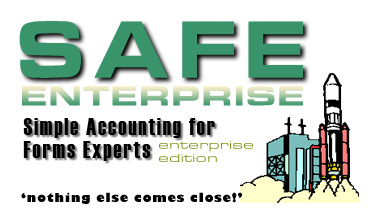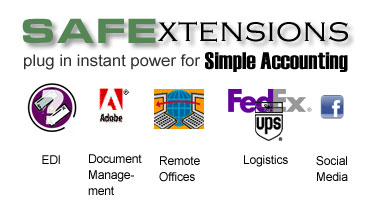Simple Accounting makes it easy to generate reports listing products which need reordering. It also can print notices reminding customers to reorder products. Both reorder reports and notices are generated from the Inventory Main Menu.
Which products are included on a reorder report or notice is based on the criteria you set for each Product Master.
Reorder notices may be generated for products whether or not they are part of a forms management program, however. they may only be generated for products linked with a Customer ID. Every time a reorder notice is printed for a product, a LAST PRINT DATE field is updated with the print date to avoid printing the same notices over and over. The LAST PRINT DATE field can be viewed at any time while editing the product.
Procedure
- Begin by pressing the Calculate Usage button so Simple Accounting can update average usage for all your products. This can take several minutes so a dialog box appears to confirm that this is what you want to do. You only do this once when in this menu. That is, after the update, you can run the report and then run the notices without having to wait for the update again.
Once usage totals have been updated you then choose the order in which the report or notices will print using the Sort Options Window.
- Next, use the Filter Window to tell the system what criteria to use in determining products that need to be reordered. This automatically tags products that Simple Accounting considers due to reorder. After the system automatically tags products, you then have the option to selectively tag or untag products to override the Simple Accountings decision on which products require reordering.
Several key fields from the Products file warrant mention when building your query:
DEPLETED The predicted date when the form will be out of stock. How this date is calculated depends on whether the product is marked as FMS or not. In the case of FMS products, the depletion date indicates that the product will be out of stock using the combined quantities at both at the customer site and in your warehouse. This is based on average usage determined by counts taken.
For non-FMS products, the depletion date is based on sales of the product. There must have been at least two sales posted within the last twelve months for this to be meaningful. An average usage is determined based on the quantities used and the frequency of orders. This allows you to automate reorder notices for customers with small orders (and offer them a forms management program to reduce their costs.)
FMS? Enter a one (1) here to select only FMS forms. EMPLOYEE Each employee can enter his/her ID thus restricting notices to their own customers. AUTOMATICALLY REORDER HOW OFTEN? The last sale date plus the REORDER HOW OFTEN? field in the FILES|Products. Use this for non-FMS products. PRINT DATE Each time a reorder notice is printed, the product record is updated with that date. Use this field to avoid reprinting reorder notices over and over by selecting only products for which notices have not been recently generated. REORDER QTY Use this to select products where the ON HAND QUANTITY is at, or has fallen below, the SUGGESTED REORDER QTY in FILES|Products. REVIEW DATE For FMS products only. The predicted DEPLETION DATE plus the LEAD TIME you have entered for each product in FILES|Products. This allows you to send notices to customers in advance of depletion. - Once you have your list of tagged records, you can now either:
- Print a report of suggested products to be reordered.
- Generate the Reorder Notices.
We suggest that you always run the report first, check it for accuracy, and then print your notices.
As with other forms in Simple Accounting, we can customize the reorder notice to fit your company’s desired form using our Forms Design Service.
Generating RFQs From Reorder Notices
Simple Accounting can generate Vendor Requests For Quotes for the currently selected Product in this browse by pressing the [RFQ] button. The RFQ form, by default, appears very much the same as a custom purchase order. Space is provided for requesting four quantities. These four quantities correspond to the suggested re-order quantities based on the time periods you entered. There is a COMBINE WITH field on each RFQ form. The program will automatically assign the same RFQ number to forms of like width and/or depth to enable you to obtain combination discounts from your vendors.
A data entry window appears asking you to enter up to three Vendor IDs and corresponding ship dates. This lets you get bids from three vendors with each bidding based on their own turn-around time. You do not have to use all three vendors; simply leave one or more Vendor IDs blank. A dialog box will ask you to proceed. Answer ‘Yes’ and the program will automatically generate the RFQs and place them in the Vendor Requests for Quotes for printing.



